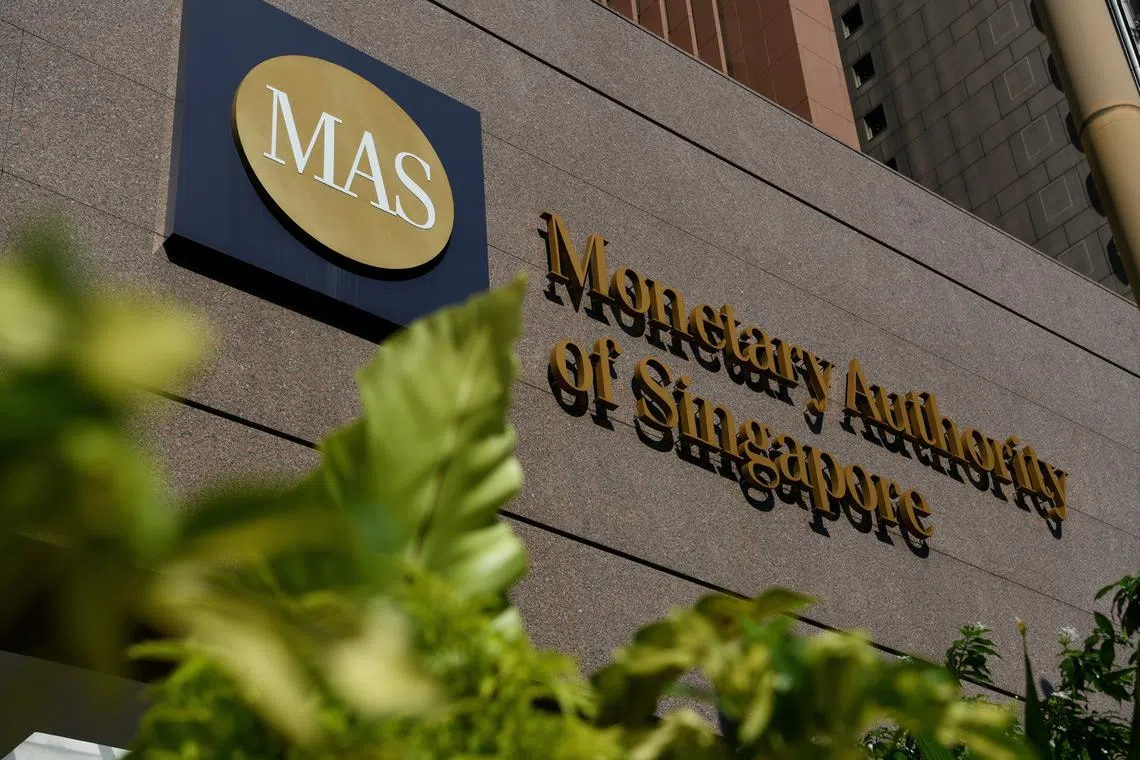MAS keeps Singdollar policy unchanged, expects 2023 growth at lower half of forecast range
Sign up now: Get ST's newsletters delivered to your inbox

Singapore’s central bank kept its monetary policy stance unchanged for the second time this year.
ST PHOTO: SHINTARO TAY
Follow topic:
SINGAPORE – In a highly anticipated decision, Singapore’s central bank on Friday kept its monetary policy settings unchanged, as it balances between the risks of a slower-than-expected economic recovery and a possible flare-up of inflation.
The Monetary Authority of Singapore (MAS) said it expects growth in 2023 to come in at the lower half of the 0.5 per cent to 1.5 per cent official forecast range.
This is despite advance estimates released on Friday
“Singapore’s GDP (gross domestic product) growth is expected to improve gradually over 2024,” MAS said in its biannual policy statement.
“However, the global economic outlook remains uncertain, and the domestic recovery could be weaker than expected.”
Despite the clouded outlook, MAS did not pivot from its stance of allowing the Singapore dollar to appreciate – due to the risks of potential price pressures both from within and from outside Singapore.
Mr Michael Wan, senior currency analyst at MUFG Bank in Singapore, said the upside surprise in third-quarter GDP may have played a part in reducing the impetus for MAS to signal any policy change.
He said MAS seems to have turned slightly more sanguine on the global growth outlook.
“We think underlying that (MAS) view is an expectation that the United States Federal Reserve will cut rates next year even as US growth achieves a relatively soft landing, while China’s growth stabilises in 2024 as it pushes out more stimulus,” Mr Wan said.
Also, the fight against inflation in Singapore has not yet been won, he noted.
While Singapore’s core inflation has been trending lower and is forecast to continue doing so, consumers and businesses face another goods and services tax hike in January 2024, and upcoming increases in carbon prices, public transport fares and water prices.
Externally, the outbreak of conflict in the Middle East threatens to push up crude oil prices even as gas, electricity and water rates are set to rise in the coming months.
Globally, the prices of oil and some food commodities have been on the rise in recent months.
“Against this backdrop, the current appreciating path of the S$Neer (Singapore dollar nominal effective exchange rate) policy band is assessed to be sufficiently tight,” MAS said.
It added that it will “closely monitor global and domestic economic developments, amid uncertainty on both inflation and growth”.
Quarterly statements
The authority also announced that it will be shifting to a quarterly monetary policy statement schedule from 2024, with statements to be released in January, April, July and October.
“This is part of MAS’ continuing efforts to enhance monetary policy communications. The next monetary policy statement will be released in late January 2024.”
Analysts said the change will give MAS more flexibility to respond to changes in growth and inflation conditions.
“The semi-annual frequency had been debated in the past, especially during crises, on whether it allows sufficient flexibility to pivot,” said Ms Selena Ling, chief economist and head of global markets research and strategy at OCBC Bank.
The switch would essentially synchronise the quarterly GDP growth releases with the monetary policy reviews, she added.
Friday’s decision extends the MAS pause in April after five rounds of tightening between October 2021 and 2022 to blunt the impact of imported inflation.
Most private economists in recent private polls had expected the MAS to maintain its policy settings as inflation continues to ease, with core inflation – which excludes accommodation and private transport costs – coming in at 3.4 per cent in August, versus its peak of 5.5 per cent in January 2023.
A few, however, had speculated over the odds of an easing of MAS’ Singdollar stance as global economic growth momentum slowed considerably in 2023.
MAS said on Friday that global economic activity has moderated, reflecting weaker growth in the eurozone and China, even as the US economy has thus far been resilient.
“In the near term, global final demand is expected to soften amid elevated interest rates. Nevertheless, the risk of a sharp global downturn, precipitated by financial vulnerabilities, has receded, compared with earlier in the year.
“Growth in Singapore’s major trading partners should gradually pick up later in 2024 as inflation continues to ease and the electronics cycle turns up modestly, although the timing and extent of the recovery is subject to significant uncertainty,” it said.
MAS said core inflation is projected to step down further to between 2.5 per cent and 3 per cent year on year by December, and slow to an average of 2.5 per cent and 3.5 per cent for 2024 as a whole.
“Although prices of crude oil have risen in recent months, global prices for most food commodities, as well as for intermediate and final goods, should be tempered by favourable supply conditions.
“Meanwhile, unit labour costs are expected to rise at a slower pace next year alongside the gradually cooling labour market.”
But MAS also said: “There are both upside and downside risks to inflation. Shocks to global food and energy prices or domestic labour costs could bring about additional inflationary pressures.
“However, a sharper-than-expected downturn in the global economy could induce a general easing of cost and price pressures.”
Mr Barnabas Gan, acting group chief economist at RHB Bank, said the prospect of sticky inflation in the near term remains a risk.
“We expect Singapore’s inflation momentum to accelerate into the fourth quarter and the first quarter of 2024 due to higher commodity prices,” he said.
Mr Gan noted that the MAS has revised its core inflation outlook to around 4 per cent for the whole of 2023, higher than its prior forecast range of 3.5 per cent to 4.5 per cent.


